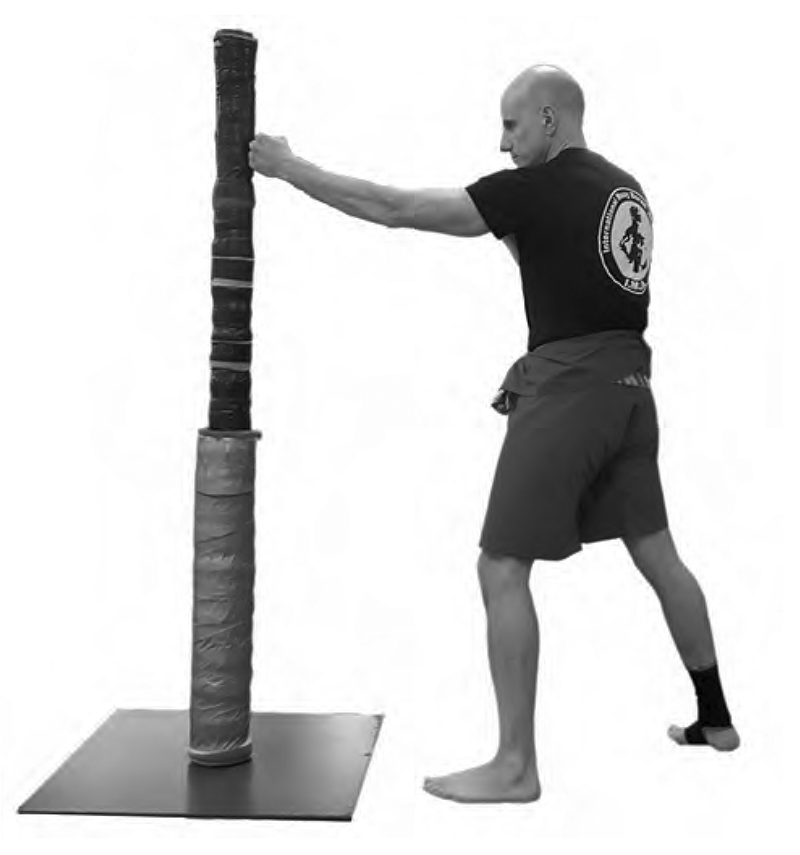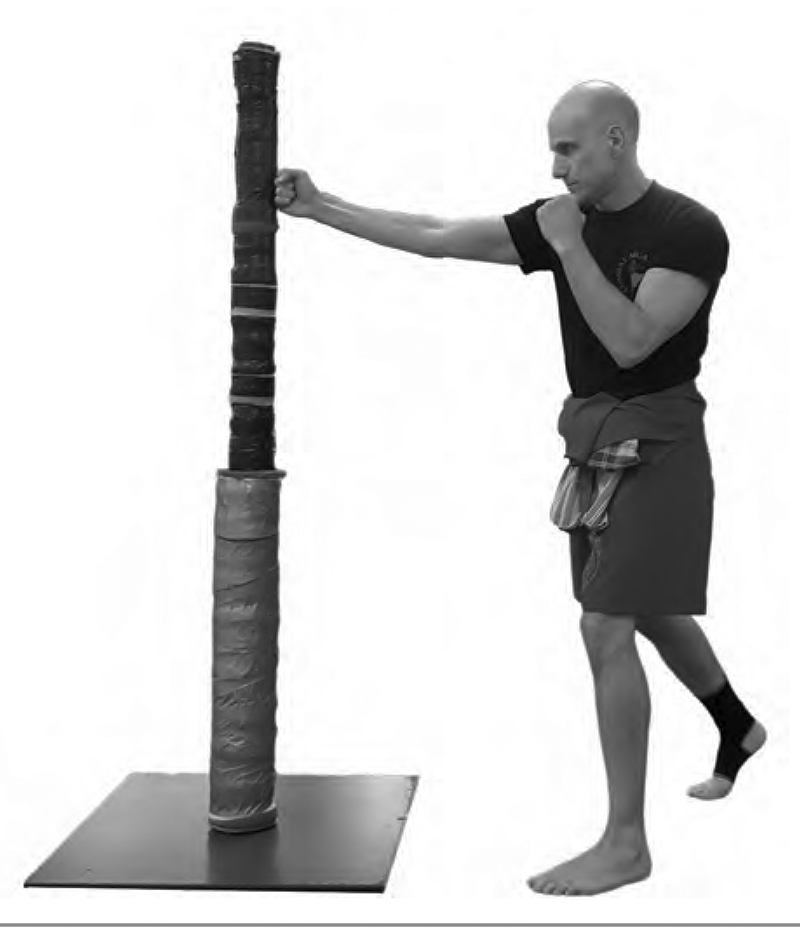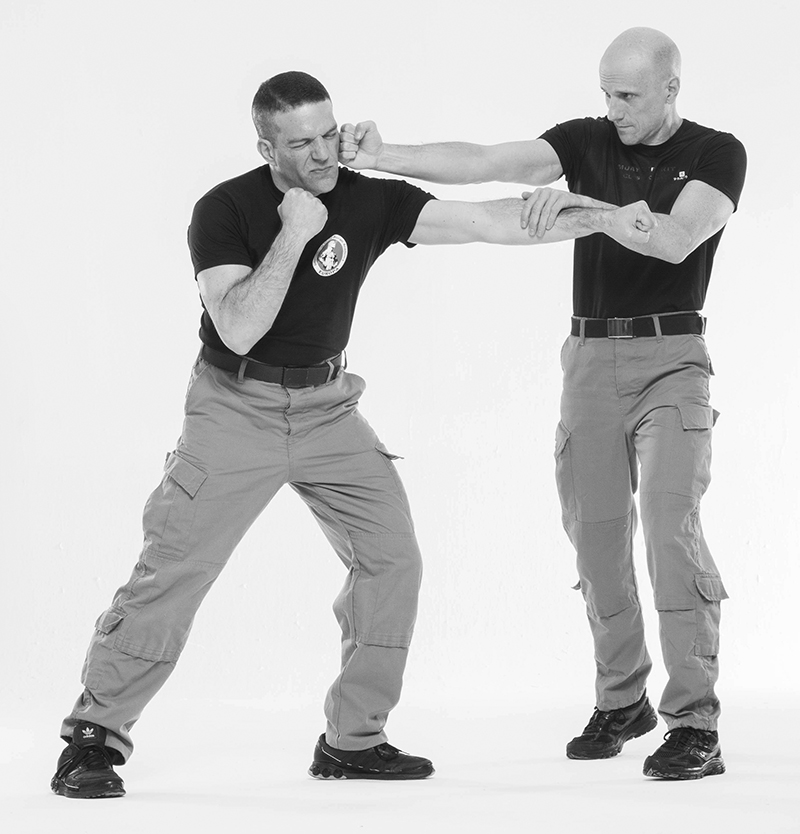
Iron post training for bareknuckle punching
The most peculiar tool used by Muay Boran IMBA practitioners to condition to the highest level the hands (knuckles, edge of hand, palm), forearms (radial and especially ulnar bone), shins, knees and feet (forefoot and heel) is the iron post. Made of a metal core covered by a thin layer of rubber or leather, fixed to a square base that allows small oscillations, the post is a fundamental help to transform any Nak Muay’s body into a real weapon. However, the use of this tool must be limited to one or two training sessions per week, starting with a limited number of strikes performed without exerting excessive power, and gradually increasing the intensity and total number of blows. By means of diligent practice, within the first 6 to 12 months the trainee will notice a marked increase in his level of bone conditioning resulting in improved impact capacity against any human body. Once a martial artist gets used to powerfully hit a metal tool, he is more than ready to attack human bones and muscles without any fear of injury but rather feeling able to break through any defense the opponent may put in place.
When starting impact training on the post, it is advisable to first begin with very basic routines; each strike has to be coordinated with proper footwork, adjusting the distance from the tool according to the body weapon used (long, middle or short range striking).
The striking techniques most commonly employed on the post are: straight vertical punches, ulnar side forearm blows, palm strikes, outside edge of hand (open or closed hand) strikes, shin and forefoot strikes.

Drill number 1: straight punching.
A properly hardened naked fist can become a formidable weapon. When the bare knuckles impact against the face of the opponent, serious damage can be inflicted. A conditioned fist can shatter bones, tear muscles and shock the internal organs. All bare-knuckle punches are potentially deadly tools when used by a skilled fighter who knows how to channel his power, making good use of kinetic energy. When a weak point is hit by a full-power bareknuckle punch, the result is often a knock out or worse. However, there is a big problem: the hand’s bones are among the most fragile in a human body and, without a proper conditioning process, the bare hands are not able to bear the shock of power punching, especially if they impact by mistake against hard targets such as the skull or the elbows. Therefore, in order to develop powerful bareknuckle punches, the hands’ bones must undergo a long and careful hardening process before trying to hit an opponent in a real fight. Proper hand conditioning is no easy task and must be approached with a 360° perspective. Not only the bones must be hardened; the muscles of the hands and forearms must be strengthened, as well as the tendons. The wrists are often the weakest link in the chain, as far as punching is concerned; for this reason a good bareknuckle power puncher must possess extremely strong yet flexible wrists that may stand the shock of impacts from every angle. Specific drills are to be used to prepare muscles and tendons to heavy impact; such drills will be illustrated in future articles. As far as impact training is concerned, the iron pole is one of the best over-all striking tool to develop durable hands for bareknuckle punching.

When you first approach iron pole punching, start your training sessions with single arm strikes. Stand with your feet parallel (Ta Song Khum or two points position) or in the basic guard position (Ta Saam Khum or three points position) at arm’s length distance from the post. Throw a left lead vertical punch into the upper portion of the post; exhale as you strike. Follow up with a right rear vertical punch to the same target. Three knuckle landing (pinkie, ring and middle finger) should be employed for both strikes. Be careful not to bend your wrist when you punch: the back of the hand and the forearm must be properly aligned on impact. At completion of the strike, the arm must be straight, elbow pointing to the ground. Each blow should hit through the target as penetration is required to develop a destructive punch.
As you become more proficient add some basic combinations, such as: left straight punch-right straight punch.
It must never be forgotten that the real secret to achieving permanent results is to be able to avoid injuries to any part of the body that is used to hit the pole: an athlete who is too “impatient” and does not want to follow the right alternation of practice and physiological recovery time, will only damage his body and eventually will feel disappointed. He who looks for miracle results coming in a short time will end up having to totally suspend training, possibly for lengthy periods. Therefore, readers must be warned not to practice bone conditioning exercises without the supervision of a trained instructor, otherwise bringing upon very serious damage. In fact, the amount and quality of these workouts are strictly individual and must be indicated by a Master who knows perfectly the characteristics and needs of each student.

